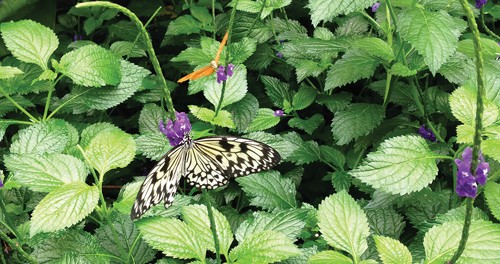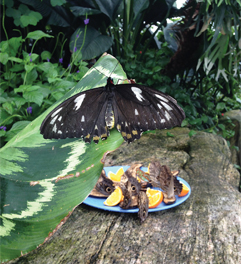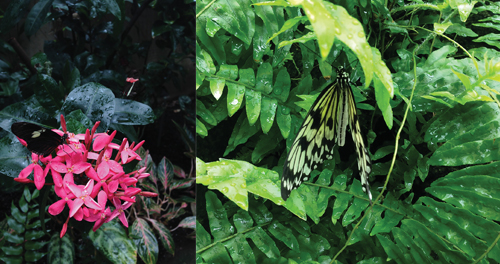A day with the lepidopterans
Niagara Parks Butterfly Conservatory

Lepidoptera, a term derived from the Ancient Greek words “scale” and “wing,” is the scientific name for a group of insects more commonly known as butterflies and moths. A visit to the Butterfly Conservatory is an eye-opening experience for students of all ages and provides another good reason for a ride to the Niagara Parks. The Niagara Parks Butterfly Conservatory is North America’s largest glass-enclosed butterfly exhibit. Visitors can not only observe but also interact with the freely flying butterflies, who often land on people’s heads and bodies, offering an up close and personal encounter with these delicate and beautiful insects.
The conservatory, which is open year round, is home to approximately 2,000 tropical butterflies. Before entering the 1,000-square-metre, rain-forest-like setting, you can watch a short orientation video. Once inside, visitors can see features such as a sixmetre waterfall and pond, extraordinary plants and beautiful flowers, as well as (if you’re lucky) butterflies making their way out of their chrysalids. They also get to witness groups of butterflies feeding on fruits. Some of the butterflies have such remarkable markings that when they are in a group, it’s initially hard to grasp what exactly you are observing but then it becomes intriguingly clear.
The Butterfly Conservatory is owned and operated by the Niagara Parks Commission, an agency of the Ontario government. It’s located on the grounds of the world-renowned Niagara Parks Botanical Gardens & School of Horticulture, north of Niagara Falls.
The Niagara Parks Commission is dedicated to providing educational programming opportunities through the conservatory and also through nature and heritage programs that can be tailored to all grade levels, from elementary to post-secondary archeology students.


In conjunction with the Monarch Teacher Network of Canada, the Commission also offers a two-day workshop that gives educators the knowledge and skills to teach multi-disciplinary lessons that will help provide excitement and wonder when teaching their students about the monarch butterfly.
Educators learn about the monarch’s life cycle, migration and habitat requirements by participating in experiential activities, including indoor simulations, outdoor games and a variety of visual and performing arts. There is also a focus on ethical and political considerations related to species conservation and social justice issues in Mexico.
Through the proven teachers-teaching-teachers method, participants build confidence and competence working with monarchs, including appropriate handling techniques, care and feeding throughout all life stages, and tagging and tracking of migrating monarchs.
Participants will leave the workshop with the knowledge, skills and tools to bring the magical story of this emblematic creature to life.
Another one-day workshop, Creating Monarch-Friendly Habitat, teaches you how to nurture butterfly populations by growing your own easy-to-maintain butterfly garden.
 The variety of education opportunities throughout the Parks is abundant. The nature programs include guided hikes and a tree-planting program. The hikes are customized for each grade level as students travel the Niagara Glen nature reserve, a biologically diverse ecosystem containing over 400 species of plants, including 75 that are rare in Ontario and Canada. The Glen provides an opportunity to see many of the geological processes that have occurred from 300 million years ago to 8,000 years ago, when the Niagara River continued to carve its way up towards its present location, creating many unique geological features. Students are led on a one-hour hike descending over 60 metres from the top of the gorge, through forests of ancient trees and remnants of Carolinian forests down to the viewpoints of the Niagara River at one of its narrowest and most treacherous points: Devil’s Hole Rapids.
The variety of education opportunities throughout the Parks is abundant. The nature programs include guided hikes and a tree-planting program. The hikes are customized for each grade level as students travel the Niagara Glen nature reserve, a biologically diverse ecosystem containing over 400 species of plants, including 75 that are rare in Ontario and Canada. The Glen provides an opportunity to see many of the geological processes that have occurred from 300 million years ago to 8,000 years ago, when the Niagara River continued to carve its way up towards its present location, creating many unique geological features. Students are led on a one-hour hike descending over 60 metres from the top of the gorge, through forests of ancient trees and remnants of Carolinian forests down to the viewpoints of the Niagara River at one of its narrowest and most treacherous points: Devil’s Hole Rapids.
Tours can focus on a variety of topics such as geology, natural history, species at risk, native plant and tree identification, invasive species, birding or sustainable outdoor recreation.
The tree-planting program shows students how to select appropriate tree species, plant and maintain trees, along with the benefits of tree planting to local wildlife.
The Heritage programs include exploring the Laura Secord Homestead, occupied by the Secord family from 1803 to 1835; the Mackenzie Printery, where students will find working heritage presses and typesetting facilities, allowing them a hands-on experience in the restored home of William Lyon Mackenzie; and Old Fort Erie, the first British fort built in what is now Ontario.
For more information on the Nature, Butterfly Conservatory and Heritage programs, please call 1-877-NIA-PARK or 905 371-0254 ext. 2. Or get visitor information at www.niagaraparks.com.

Leave a comment